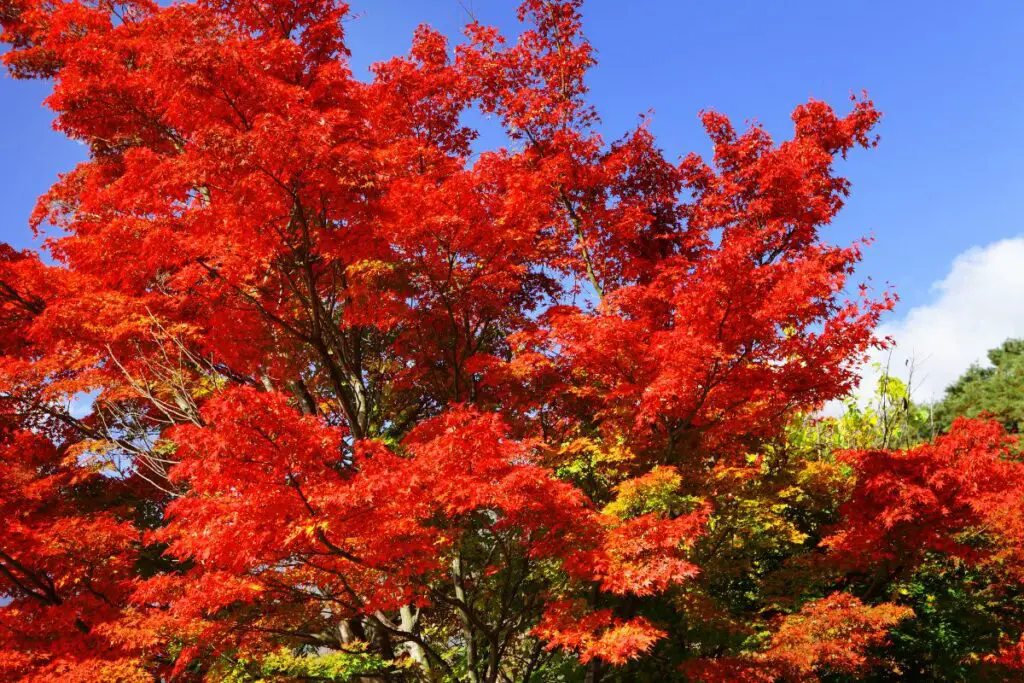Clay soil is a common type of soil found in many parts of the world. It can be difficult to find plants that thrive in clay soils, but with the right knowledge and advice, it’s possible to select trees that will flourish.
In this article, we’ll explore 7 trees that are best suited for heavy soils and provide expert tips on how to choose them.
We’ll also discuss planting solutions for those looking to create a thriving garden or landscape despite having clay soil conditions. Read on for more information about these amazing trees!

Table of Contents
Planting Solutions: Choosing Trees for Clay Soil
When it comes to planting solutions, choosing the right tree for clay soil can be a challenge.
Clay soils are heavy and often lack drainage, but there are several trees that thrive in this environment.
Here is a list of 7 trees that grow best in clay soil:
1. Red Maple
This deciduous tree grows quickly and has an attractive red-orange color during the fall months.
It prefers moist conditions with full sun or partial shade exposure and tolerates wetter soils better than most other species.
2. Bald Cypress
This evergreen coniferous tree is tolerant of both dry and wet conditions, making it ideal for areas with poor drainage or standing water issues due to its ability to survive flooding events without damage from root rot or other diseases caused by excess moisture levels over time.
3. Sweetgum
A fast-growing deciduous species, sweetgums have beautiful star-shaped leaves which turn yellowish orange during autumn months before falling off the branches each winter season.
They prefer full sun exposure but will tolerate some shade as well as occasional flooding events without any major damage being done to their root system.
4. White Oak
An iconic American hardwood species, white oaks provide excellent shade coverage while also being resistant against many common pests such as gypsy moths, Japanese beetles, aphids, etc…
They require plenty of sunlight throughout the day so they should be planted away from buildings where possible.
5. Silver Maple
Another fast-growing deciduous option silver maples have stunning silvery green foliage which turns yellowish orange during autumn months before dropping off each winter season.
These trees prefer moist environments so they do well when planted near bodies of water such as streams ponds lakes etc…
6. Willow Tree
Willows are known for their graceful weeping form making them popular choices among landscapers looking for ornamental plants around pools patios decks etc…
Willows need plenty of sunlight throughout the day but will tolerate some light shade too plus they’re very tolerant towards standing water issues since their roots can reach down deep into saturated soils easily enough without suffering any major damages over time.
7. Hackberry
Medium-sized deciduous tree hackberries boast bright green foliage all year round turning golden yellow during fall months before shedding their leaves each winter season.
These trees thrive best when planted in sunny locations away from buildings where possible however they’re also quite adaptable to different types of soil including those containing high amounts of clay particles too!
Uncovering the Top 10 Trees for Clay Soil
Clay soil is a common type of soil found in many parts of the world. It has its own unique characteristics that make it difficult to grow certain plants and trees.
However, there are some trees that thrive in clay soils, making them ideal for planting in these areas.
In this article, we will uncover the top 10 trees for clay soil so you can choose the right one for your garden or landscape project!
The first tree on our list is the Japanese maple (Acer palmatum). This beautiful deciduous tree grows best in moist but well-drained clay soils with plenty of organic matter added to help retain moisture and nutrients.
The Japanese maple also prefers partial shade but can tolerate full sun if given enough water during dry periods. Its vibrant foliage makes it an excellent choice as an accent plant or focal point within a landscape design.
Next up is the American beech (Fagus grandifolia). This majestic native tree does well even when planted in heavy clay soils as long as they have good drainage and are not overly wet or soggy during rainy periods.
Beeches prefer full sun exposure and their attractive bark adds year-round interest to any outdoor space!
Third on our list is bald cypress (Taxodium distichum), which loves growing in wetter conditions than most other types of trees do – including those found growing naturally near swamps and riversides where there’s plenty of standing water present throughout much of the year!
Bald cypresses need at least six hours per day of direct sunlight exposure too; otherwise, they won’t reach their maximum potential growth rate nor will they look their best either aesthetically speaking!
Fourthly we have red oak (Quercus rubra) – another native species which thrives when planted into heavy clays provided it’s been amended with composted manure beforehand; this helps keep moisture levels balanced while providing essential nutrients needed by red oaks too – such as nitrogen & phosphorus amongst others…
Red oaks tend towards preferring slightly acidic pH ranges so bear this factoid in mind before deciding whether or not these beauties should grace your yard/garden area(s)!
Discover the Best Trees to Thrive in Clay Conditions
If you have clay soil in your garden, you may be wondering which trees are best suited to thrive in these conditions.
Clay soil can be difficult to work with and is often prone to waterlogging, but there are a number of tree species that will tolerate the heavy soils and provide plenty of shade for your outdoor space.
The first on our list is the English Oak (Quercus robur). This majestic tree has been a symbol of strength since ancient times and it’s no surprise why – this hardy species can survive even extreme weather conditions thanks to its deep roots which reach down into moisture-rich subsoil layers beneath the surface.
The English Oak also provides excellent shade cover due its broad canopy, making it an ideal choice if you want some respite from hot summer days!
Another great option is Silver Birch (Betula pendula). This beautiful deciduous tree grows quickly and produces stunning white bark as it matures – perfect for adding interest to any landscape design!
Its shallow root system makes it suitable for wetter areas where other trees might struggle, while its ability to cope with cold temperatures means that this species won’t suffer too much during winter months either.
Other good choices include Field Maple (Acer campestre), Sweet Chestnut (Castanea sativa), or Hornbeam (Carpinus betulus).
All three varieties are tolerant of both dry spells and waterlogged ground – making them ideal candidates if your garden experiences periods of heavy rainfall or drought throughout the year.
They also provide attractive foliage all year round; Field Maple’s leaves turn yellow during autumn while Sweet Chestnut’s glossy green leaves remain until late winter when they start turning brown before dropping off completely come springtime!
Finally, Hornbeam offers up a mix of light green summer foliage followed by golden yellow hues come autumn – providing an ever-changing display throughout each season!
Expert Advice: Selecting Trees Suited to Clay Soil
When selecting trees for clay soil, it is important to consider the tree’s root system and its ability to tolerate wet conditions.
Clay soils are heavy and retain moisture, so trees with shallow roots may struggle in these conditions.
Prices pulled from the Amazon Product Advertising API on:
Product prices and availability are accurate as of the date/time indicated and are subject to change. Any price and availability information displayed on [relevant Amazon Site(s), as applicable] at the time of purchase will apply to the purchase of this product.
Trees that prefer well-drained soil should be avoided as they will not thrive in a clay environment.
Fortunately, there are many varieties of trees that can handle the unique challenges of growing in clay soil.
Some popular choices include Bald Cypress, Red Maple, Sweetgum, White Oak, and Willow Oak which all have deep root systems capable of penetrating dense soils while also providing excellent shade cover.
For those looking for an ornamental option suited to a clay environment then Crape Myrtle or Dogwood are both great options as they provide beautiful blooms during springtime while their strong root systems help them withstand wetter periods throughout the year.
Finally, if you’re looking for something more unusual then consider planting a Chinese Pistache or American Sycamore – both species offer attractive foliage along with good drought tolerance making them ideal candidates for areas prone to flooding or waterlogging due to their extensive root systems which allow them access nutrients even when submerged underwater!
Conclusion
In conclusion, planting trees in heavy clay soil can be a challenge, but with the right species, it can be done successfully.
The top 7 trees for clay soil mentioned in this article offer a range of options for different climates, light conditions, and garden styles.
When planting trees in clay soil, be sure to prepare the soil properly, provide proper watering and fertilization, and be mindful of their mature size and potential for root damage to nearby structures.
With the right care and attention, you can enjoy the benefits of these trees for many years to come. So, choose the right tree for your clay soil and watch it thrive!
- How to Build a Planter Box for Bamboo: A Step-by-Step Guide

- Can Robotic Lawnmowers Handle Steep Slopes?

- Do You Need a Specific Lawn for a Robotic Lawnmower? Expert Advice

- Are Robotic Lawnmowers Safe for Pets and Children? Safety Features of Robotic Lawnmowers

- Why Use Robotic Lawnmowers? Advantages of Using a Robotic Lawnmower

- Is the GARDENA SILENO City 300 Cordless or Corded? A Clear Answer















